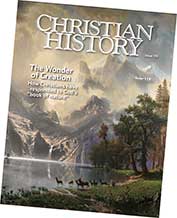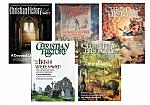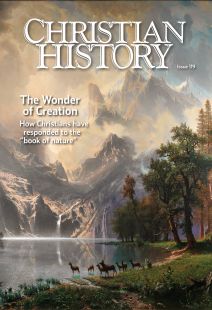Fellow travelers?
John Muir (1838–1914)
Few American environmentalists and nature writers are as well known as John Muir; born in Scotland, he moved to Wisconsin at age 11. His family belonged to the Disciples of Christ, and as a child, Muir memorized more than half the Old Testament and all of the New.
Order Christian History #119: The Wonder of Creation in print.
Subscribe now to get future print issues in your mailbox (donation requested but not required).
While studying botany at the University of Wisconsin, Muir discovered his inspiration. In The Story of My Boyhood (1913), he recalled being baffled by his instructor’s claim that a rough and thorny black locust is related to spindly pea plants. The resulting explanation filled him with wonder: “Like everybody else I was always fond of flowers, attracted by their external beauty and purity. Now my eyes were opened to their inner beauty, all alike revealing glorious traces of the thoughts of God, and leading on and on into the infinite cosmos.” This opened Muir to another way of knowing God beyond the tradition he had been raised in.
Muir moved to southern Ontario during the Civil War and spent nearly a year exploring the region around Lake Huron’s Georgian Bay. After returning to the States, he was nearly blinded in an accident in 1867. That temporary loss of sight set him on a path that led him hike to Florida, spend time in Cuba, catch a boat to New York, and end up in California.
There Muir discovered untouched nature. He divided the world into two parts: the impure regions of civilization and pure creation as received directly from the hands of God. In Yosemite he found the latter and worked tirelessly to preserve it as a national park.
Muir rubbed shoulders with some of the most influential people of his day. Ralph Waldo Emerson (see p. 33) visited him and offered Muir a professorship at Harvard, and Theodore Roosevelt (1858–1919) escaped his presidential entourage to spend three days exploring Yosemite with Muir (see “Did You Know?”, inside front cover). Eventually in 1892 Muir cofounded the Sierra Club. Over time he published 12 books and more than 300 articles, all exposing readers to the importance and fragility of the natural world.
Alexander Schmemann (1921–1983)
“In the radiance of His [God’s] light the world is not commonplace. The very floor we stand on is a miracle of atoms whizzing about in space.” So wrote émigré Russian priest and scholar Alexander Schmemann in a deeply complex theological book that nevertheless formed many people’s attitudes toward God’s creation. He stood in a long line of theologians in the Eastern Orthodox tradition—going back to the church fathers—intrigued by the relationship between God and creation.
Born in Estonia to Russian parents, Schmemann’s family moved to France when he was still young. There he attended the University of Paris and the Orthodox Theological Institute of St. Sergius, the center of Russian Orthodox scholarship. In 1946 he was ordained a priest and began teaching church history at St. Sergius.
In 1951 Schmemann came to St. Vladimir’s Theological Seminary just north of New York City; serving as dean from 1962 until his death, he oversaw the formation of hundreds of Orthodox priests. Though an academic and administrator, Schmemann was also a pastor greatly concerned with the health of the church. For 30 years his weekly sermons were broadcast in Russian throughout the former Soviet Union on “Radio Liberty.” In the United States, he helped establish the Orthodox Church in America.
Schmemann’s theology of creation informed and was informed by the sacramental life of the church. In his most famous book, For the Life of the World (1963), he urged Christians repeatedly not to divorce their spiritual lives from the physical world: “It is the very joy of the Kingdom that makes us remember the world and pray for it. It is the very communion with the Holy Spirit that enables us to love the world with the love of Christ.”
Annie Dillard (b. 1945)
Annie Dillard’s Pilgrim at Tinker Creek (1974), beloved by numerous Christian readers, poetically—but unromantically—describes her observations of nature near Tinker Creek in Virginia’s Blue Ridge Mountains. As she explored her small corner of creation, the problem of evil was ever present; readers have made much of her watching a water bug inject a frog with digestive enzymes, then slowly drain the creature of its innards.
This reality made it difficult for Dillard to draw easy conclusions about faith; she characterized the book as an attempt “to describe the creator, if any, by studying creation.” This theme of searching for God runs through much of her work.
The success of the book—it won the 1975 Pulitzer for general nonfiction—established her as one of the most prominent American nature writers of the twentieth century. Though she resisted the label, critics compared her with the classics—especially Henry David Thoreau (see p. 33), who, like Dillard, was touched by Christianity while ultimately refusing to claim it. (The master’s thesis she wrote at Hollins College in 1968 is titled “Thoreau and Walden Pond.”)
In addition to a number of highly praised works of nonfiction—Holy the Firm (1977), Teaching a Stone to Talk (1982), and The Writing Life (1989)—Dillard also wrote two novels, The Living (1992) and The Maytrees (2007); a memoir, An American Childhood (1987); and a book of poetry titled Tickets for a Prayer Wheel (1974).
Though her writing is imbued with a near mystical spirituality, in recent years Dillard has remained reticent about her personal beliefs. In the early 1990s, she converted to Catholicism, but by the time she wrote For the Time Being in 1999, she noted, “I quit the Catholic Church and Christianity; I stay near Christianity and Hasidism.” The vita on her official website now lists her religion as “none.”
A Rocha (founded 1983)
A Rocha—in Portuguese, “the rock”—began when two Anglican priests and their families moved to the Algarve region of Portugal in the 1980s, driven by a desire to respond as Christians to the environmental crises of the day. There they established a bird observatory and field study center. Now it has grown into an international network with bases in over two dozen countries.
Yet even as A Rocha broadened, it remained decidedly local, each country a separate entity with its own projects. In the United States, A Rocha is developing a community garden on the campus of Wheaton College in Illinois and running children’s nature camps in Nashville. In Ghana a mangrove restoration project is conserving wetlands; in Switzerland researchers are surveying grasslands. At one Anglican church in Winnipeg, Canada, children made jam and pizza with the fruits and vegetables they had learned to grow. “Our project here links people with food, community, and creation,” said an A Rocha community organizer there. “One six-year-old girl astonished her parents by identifying all the plants in the garden—even odd ones like tomatillos. Our security guard was given 40 pounds of potatoes, but since he had no cooking facilities in his rooming house, he donated them to the soup kitchen where he ate his meals.”
The organization’s five core commitments are Christian, Conservation, Community, Cross-Cultural, and Cooperation. Founder Peter Harris said in a 2011 Christianity Today interview that the movement is “driven by biblical theology. It’s not a Christian attempt to ‘save the planet.’ It’s a response to who God is.” CH
This article is from Christian History magazine #119 The Wonder of Creation. Read it in context here!
By Matt Forster
[Christian History originally published this article in Christian History Issue #119 in 2016]
Matt Forster is a freelance writer and editor from Clarkston, Michigan.Next articles
Something here sounds familiar
An evangelical professor responds to Pope Francis’s call for creation care
Loren WilkinsonCreation care: Recommended resources
Where can you go to learn more about the relationship between Christians and God’s creation? Here are some recommendations from CH editorial staff and this issue’s authors
the editorsChristian History Timeline: China in the 20th Century
The golden age of Protestantism in China
the editorsSupport us
Christian History Institute (CHI) is a non-profit Pennsylvania corporation founded in 1982. Your donations support the continuation of this ministry
Donate





